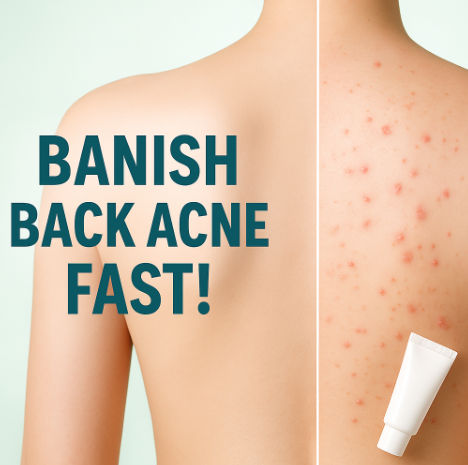
Understanding Back Acne: Why It Happens
Back acne, often referred to as “bacne,” is more than just a cosmetic nuisance—it can be painful, irritating, and affect self-confidence. The main culprit behind bacne is an overproduction of naturally generated oil, known as sebum, by the sebaceous glands located on your back and shoulders. When sebum mixes with dead skin cells, pores get clogged, creating the perfect environment for acne to develop. Understanding the causes is the first step to treating it effectively.
What Causes Back Acne?
1. Sweat and Bacterial Growth
Sweating is normal, but when sweat combines with sebum and dead skin cells, it creates an ideal breeding ground for bacteria, specifically Cutibacterium acnes (C. acnes). This bacteria irritates the skin, inflaming pores and leading to acne. Frequent workouts or hot weather can exacerbate this issue, making bacne more common during summer.
2. Friction from Clothes and Accessories
Tight clothing, backpacks, or straps that rub against your back can irritate the skin and trigger breakouts. The friction creates micro-abrasions on the skin, inflaming pores and worsening acne. Choosing breathable fabrics like cotton or linen and ensuring loose-fitting clothes can drastically reduce irritation.
3. Poor Dietary Habits
Foods with a high glycemic index, such as sugary snacks, sodas, and refined carbohydrates, spike blood sugar levels rapidly. Your body responds by producing insulin, which in turn stimulates insulin-like growth factor 1 (IGF-1). This hormone increases sebum production, fueling acne development. Incorporating low-glycemic foods like fruits, vegetables, beans, and whole grains can help regulate sebum levels.
4. Hormonal Imbalances
Hormones play a crucial role in back acne. During puberty, menstruation, or times of hormonal fluctuations, androgen levels rise, stimulating sebaceous glands and overproducing oil. This excess sebum can clog pores and lead to persistent bacne.
5. Genetics
If a parent struggled with back acne, there’s a higher chance their child will experience it too. Genetics influences both sebum production and skin sensitivity, making some individuals more prone to breakouts.
6. Stress Levels
Everyday stress triggers hormones like cortisol, which can increase oil production and inflammation in the skin. Managing stress through mindfulness, exercise, or proper sleep is often overlooked but vital for acne prevention.
Video : How to Get Rid of Chest and Back Acne
How to Treat Back Acne Effectively
1. Benzoyl Peroxide
Benzoyl peroxide is a proven over-the-counter solution that kills acne-causing bacteria and unclogs pores. A 5.3% topical formulation is ideal for minimizing irritation while still effectively treating mild to moderate bacne.
2. Salicylic Acid (BHA)
Salicylic acid works as an exfoliant, helping remove dead skin cells and prevent clogged pores. It is especially beneficial for sensitive skin and can be found in creams, gels, or specialized body washes. Research shows that advanced formulations like supramolecular salicylic acid peels significantly reduce moderate-to-severe acne.
3. Retinoids
Topical retinoids, such as tretinoin or adapalene, normalize skin cell turnover and help prevent pore blockages. Using a moisturizer afterward reduces dryness and irritation. Retinoids are effective for long-term acne prevention and skin renewal.
4. Summer-Ready Skin Care
Sweat plays a huge role in bacne, especially during hot weather. Wearing lightweight, breathable fabrics and changing out of sweaty clothes immediately can prevent pore blockage. Loose-fitting cotton or linen reduces friction and irritation, keeping your back acne-free.
5. Diet Adjustments
Cutting back on processed sugar, fast food, and refined carbohydrates while incorporating low-glycemic foods helps control insulin spikes and sebum production. A balanced diet rich in vegetables, whole grains, and healthy proteins supports clearer skin from the inside out.
6. Professional Treatments
Severe or persistent back acne may require medical intervention. Dermatologists can recommend prescription-strength treatments, chemical peels, or laser therapy depending on the severity and type of acne. Early professional intervention reduces scarring and speeds up recovery.
Preventing Back Acne: Long-Term Solutions
Consistency is key. Maintaining a regular cleansing routine, using non-comedogenic skincare products, wearing breathable fabrics, and managing stress all contribute to acne prevention. Avoid over-washing, as this can strip natural oils and trigger more sebum production.
Video : How To Treat Back Acne FAST | Doctors Tips | Skin of Colour Asian/Black | Treat Backne | DR V
Conclusion: Clearer Skin Starts with Understanding
Back acne is common, but understanding the causes—from sweat and friction to hormones, diet, and stress—empowers you to take control. With targeted treatments like benzoyl peroxide, salicylic acid, and retinoids, along with lifestyle changes and professional care when needed, you can reduce breakouts and prevent future flare-ups. By combining prevention with effective treatment, achieving healthy, acne-free skin is possible.


